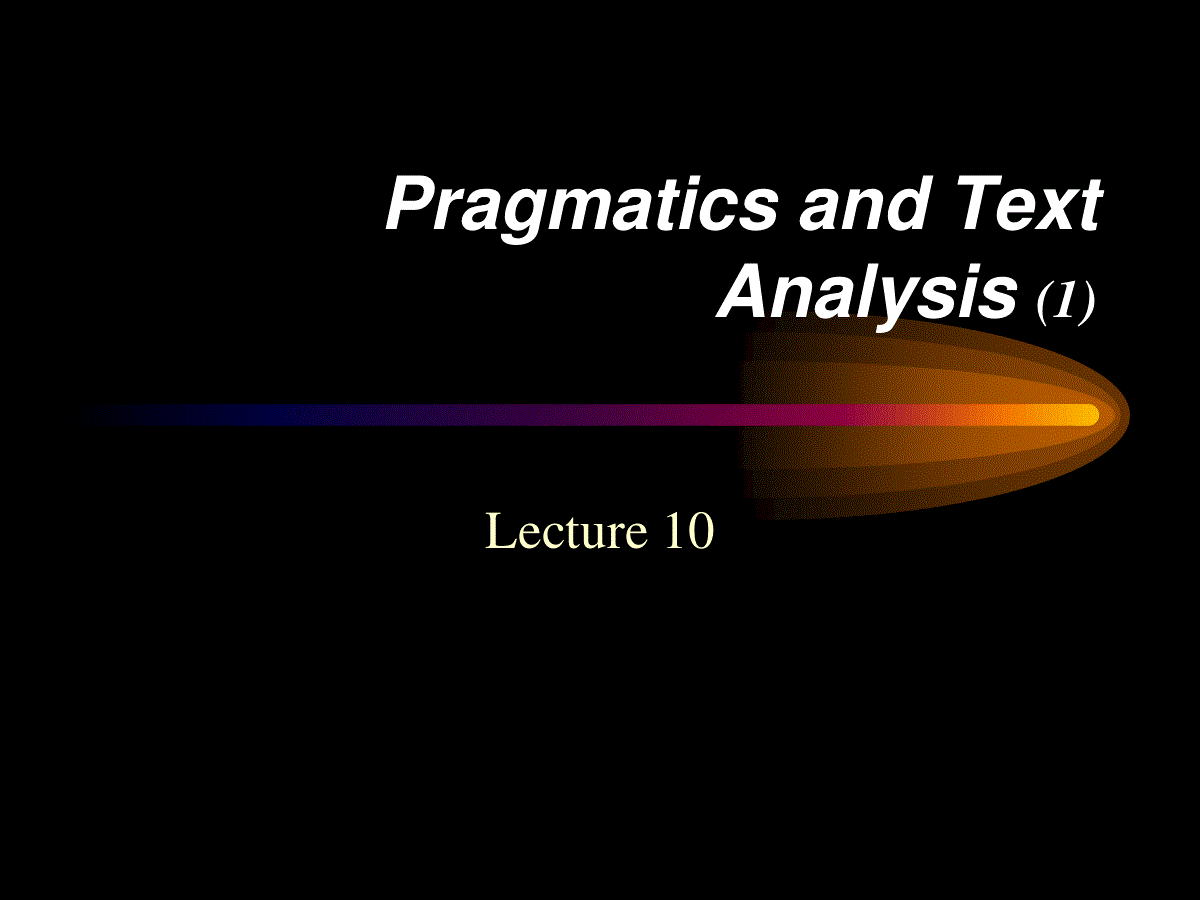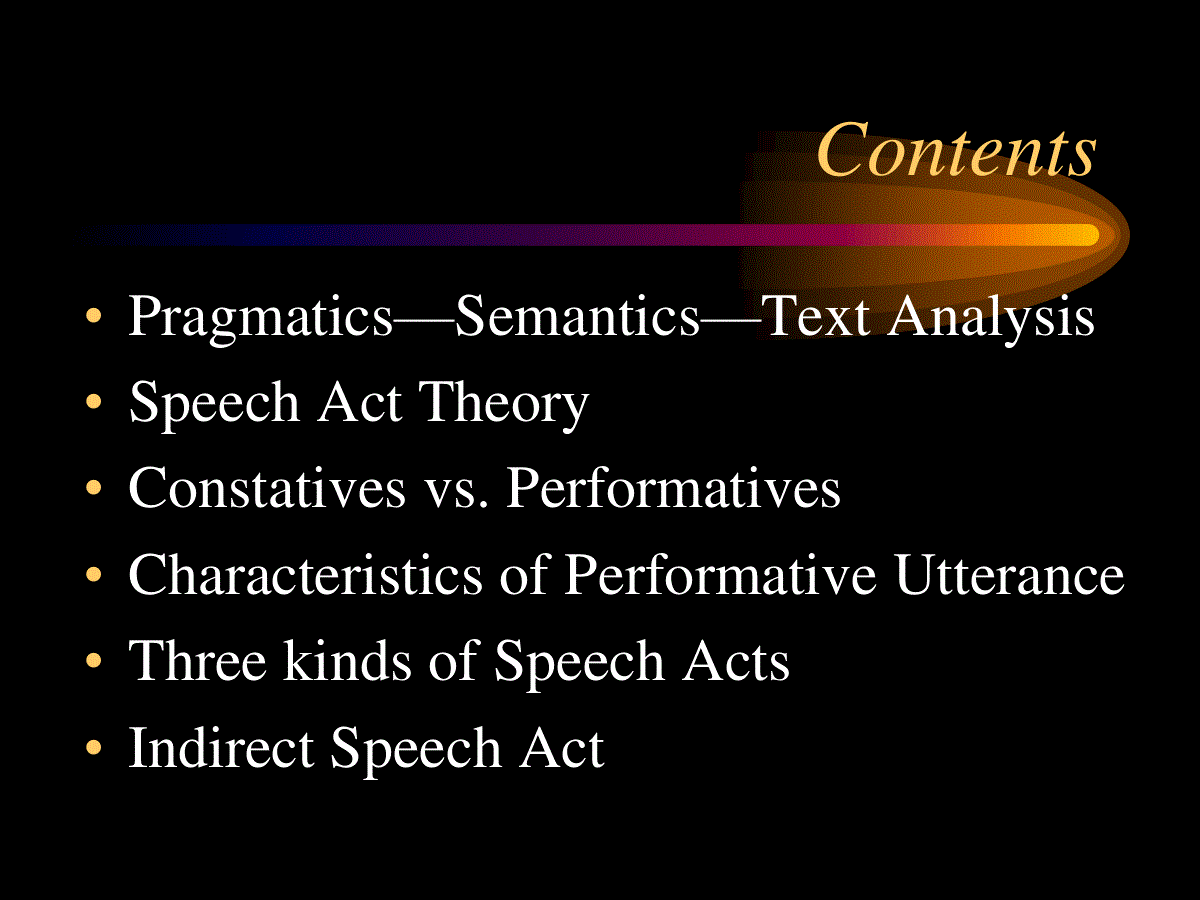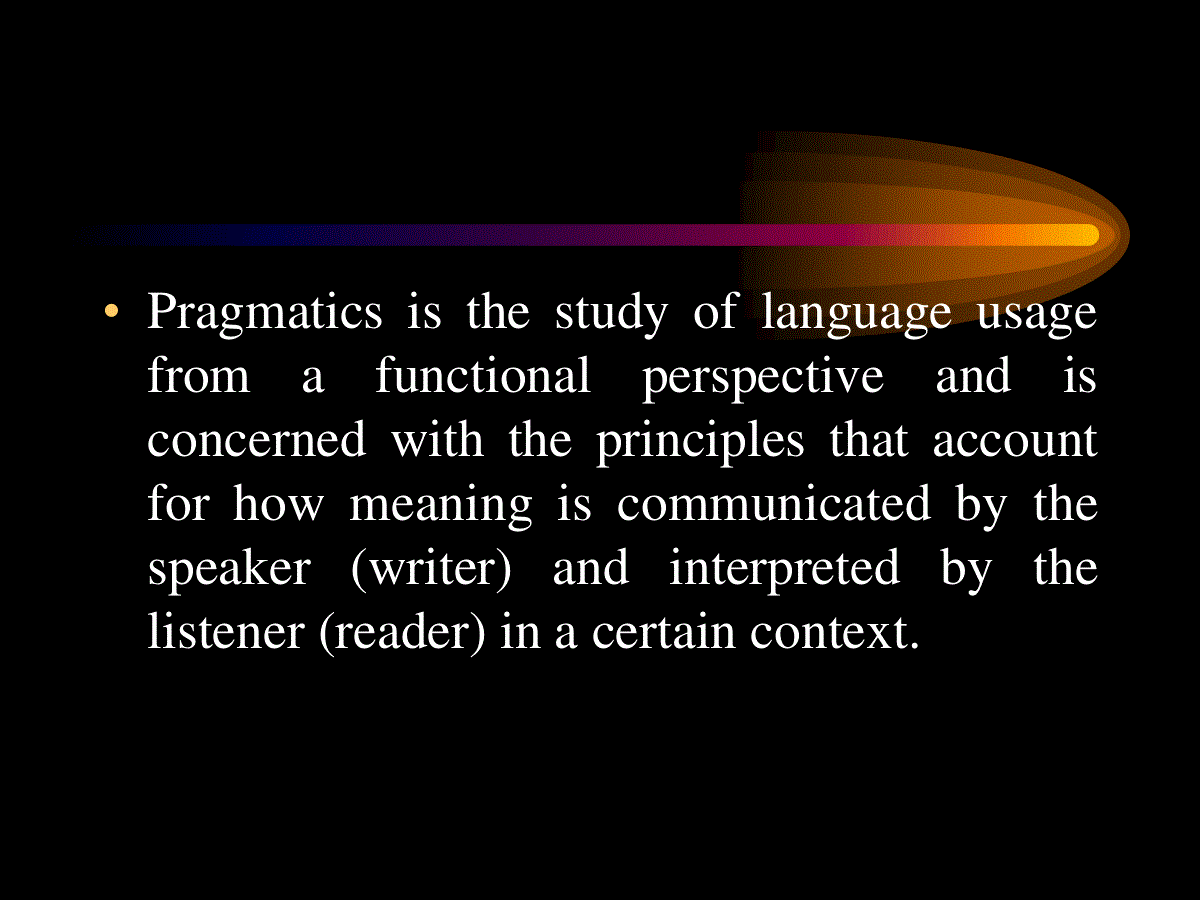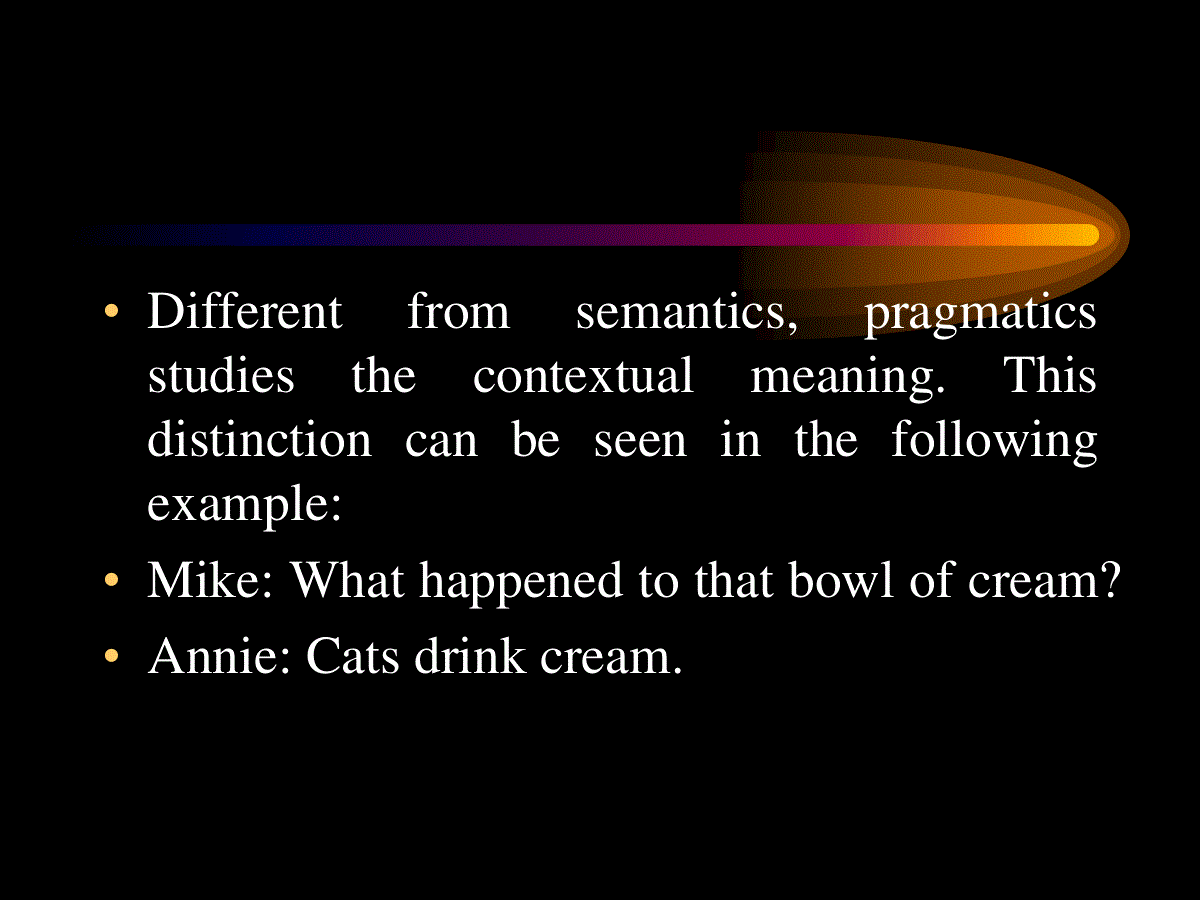当前位置:首页 > 商业/管理/HR > 公司方案 > Lecture10 Pragmatics and Text Analysis (I)
PragmaticsandTextAnalysis(1)Lecture10Contents•Pragmatics—Semantics—TextAnalysis•SpeechActTheory•Constativesvs.Performatives•CharacteristicsofPerformativeUtterance•ThreekindsofSpeechActs•IndirectSpeechAct•Pragmaticsisthestudyoflanguageusagefromafunctionalperspectiveandisconcernedwiththeprinciplesthataccountforhowmeaningiscommunicatedbythespeaker(writer)andinterpretedbythelistener(reader)inacertaincontext.•Differentfromsemantics,pragmaticsstudiesthecontextualmeaning.Thisdistinctioncanbeseeninthefollowingexample:•Mike:Whathappenedtothatbowlofcream?•Annie:Catsdrinkcream.•Semantically,Annie'sreplycanbeparaphrasedasDomesticfelinesconsumetheliquidfatofmilk,butpragmatically,AnnieprobablyimpliesThatbowlofcreamwasprobablyeatenbyourcat.Inotherwords,semanticsfocusesonthemeaningthatcomesfromlinguisticknowledge,whilepragmaticsconcentratesonthoseaspectsofmeaningthatcannotbepredictedbylinguisticknowledgealoneandtakesintoaccountourknowledgeaboutthephysicalandsocialworld.Whatdoespragmaticsstudy?Howdoesitdifferfromtraditionalsemantics?•Similarities:bothstudythemeaning•Differences:SemanticsPragmaticsAboutlanguageLanguageisaself-containedintrinsicsystemTheuseoflanguageandextra-linguisticfactorsareconsideredStudymethodStudiedinisolationfromlanguageuse.Studiedinthecontextoflanguageuse.•Differencebetween•Pragmaticsalsodiffersfromsyntaxinthatpragmaticsisconcernedwiththeappropriatenessofnaturallyoccurringutterances.Forexample,thefourutterancesinthefollowingdialogueareallsyntacticallyincomplete,butpragmaticallytheyareallappropriateintheparticularcontext.•Jane:Coffee?•Steve:Sure.•Jane:White?•Steve:White.•Likepragmatics,textanalysisisalsoconcernedwithlanguageusedinparticularcontexts.Itisthelinguisticanalysisofnaturallyoccurringconnectedspokenorwrittentexts.Inotherwords,itisthestudyoflinguisticunitslargerthansentencesorclauses.SpeechActTheory•AspointedoutbytheBritishphilosopherAustinin1962,sentencesarenotalwaysutteredjusttosaythings,butrather,theyareusedtodothings.Basedonthisassumption,AustinadvancedtheSpeechActTheory,whichisnowgenerallyviewedasoneofthebasictheoriesofpragmatics.•Alllinguisticactivitiesarerelatedtospeechacts.Therefore,tospeakalanguageistoperformasetofspeechacts,suchasstatement,command,inquiryandcommitment.•Speechacttheoryisanimportanttheoryinthepragmaticstudyoflanguage.Itmeans:Weareperformingactionswhenwearespeaking.•TwomodelsofAustin'sSpeechacttheory•ModelI:Constatives(述事话语)vs.Performatives(行事话语)•ModelII:Aspeakermightbeperformingthreeactssimultaneouslywhenspeaking:Locutionaryact(言内行为),Illocutionaryact(言外行为),andPerlocutionaryact(言后行为).•Locutionaryact:theactofsaying,theliteralmeaningoftheutterance;•Illocutionaryact:theextrameaningoftheutteranceproducedonthebasisofitsliteralmeaning;•Perlocutionaryact:theeffectoftheutteranceonthehearer,dependingonspecificcircumstances.Threekindsofacts•Whenasentenceisuttered,thespeakerisperformingthreekindsofspeechactssimultaneously:locutionaryact,illocutionaryact,andperlocutionaryact.•Amongthesekindsofspeechacts,pragmatistsaremostinterestedinillocutionaryact.Thisisbecauseillocutionaryactconformstothespeaker'sintentionandintheirstudyofpragmatics,pragmatistsaremostinterestedinhowaspeakerexpresseshisintentionandalsohowhisintentionisrecognizedbythehearer.FivetypesofillocutionaryspeechactsAccordingtoSearle,therearefivegeneraltypesofthingswedowithlanguage:1.Representatives:statementsoffact,assertions…2.Directives:commands,orders,requests…3.Commissives:promises,threats,refusals…4.Expressives:statementsofpleasure,pain,likes…5.Declarations:theutterancesofchangingasituationRelationshipbetweenLocutionaryact&Illocutionaryact•Alocutionaryactmayhavedifferentillocutionaryforcesindifferentcontexts.Inotherwords,anutterancemaybeinterpretedasadirectorindirectspeechact.•Forexample,theutteranceofDon'tyouthinkit'stoostuffyinhere?maybeinterpreted(a)literallyasaninquiryfortheaddressee'sopinionoftheairconditionintheplacewherethesentenceisuttered,(b)asanindirectstatementdescribingthestuffyatmosphereintheplacewheretheutteranceoccurs,and(c)asanindirectrequestfortheaddresseetoopenthewindowortoturnontheair-conditioner.•Similarly,anillocutionaryactcanbeperformedbydifferentlocutionaryacts.Forexample,theillocutionaryactofaskingtheaddresseetoopenthedoormaytake,amongmanyothers,thefollowingthreedifferentlocutionaryacts:•a.Command:Openthedoorplease.•b.Request:Wouldyoupleaseopenthedoor?•c.Statement:Thedoorbellisringing.IndirectSpeechAct•Asmentionedpreviously,indirectspeechactreferstoanindirectrelationshipbetweenthepropositionalcontentandillocutionaryforceofanutterance.Asentencewhichexpressesanindirectspeechactisanindirectperformative.•ExampleAbelowisanexplicitperformativeinwhichthespeechactofrequestisdirectlycodedbytheperformativeverbrequest.ExampleBisanindirectperformativeinwhichthespeechactofrequestisindirectlyexpressedbyaquestion:•A.Irequestthatyouhelpmewiththeluggage.•B.Canyouhelpmewiththeluggage?•AsrevealedinExampleA,thespeaker'sintentioncanbedirectlyidentifiedintheperformativeverbinanexplicitperformative,butintheindirectp





 三七文档所有资源均是用户自行上传分享,仅供网友学习交流,未经上传用户书面授权,请勿作他用。
三七文档所有资源均是用户自行上传分享,仅供网友学习交流,未经上传用户书面授权,请勿作他用。
本文标题:Lecture10 Pragmatics and Text Analysis (I)
链接地址:https://www.777doc.com/doc-3212566 .html